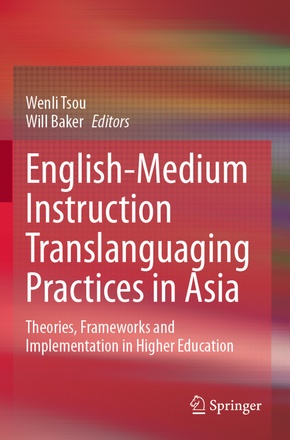
English-Medium Instruction Translanguaging Practices in Asia - Theories, Frameworks and Implementation in Higher Education
| Verlag | Springer |
| Auflage | 2022 |
| Seiten | 195 |
| Format | 15,5 x 1,1 x 23,5 cm |
| Gewicht | 330 g |
| Artikeltyp | Englisches Buch |
| EAN | 9789811630033 |
| Bestell-Nr | 81163003DA |
This book examines translanguaging pedagogy in Asia's English-medium instruction (EMI) higher education. It presents an overview of concepts and common issues, and case studies from specific contexts in Asia. The book first interrogates macro-level English-medium instruction policies and implementation from English as a lingua franca (ELF) perspectives. Following this, implications of English as a lingua franca on English-medium instruction pedagogy will be explored, with a theoretical framework of 'translanguaging pedagogy' developed. The book concludes with a discussion on translanguaging and how the concept contributes to English-medium instruction in Asia. Through the book, the content focuses on the specificity of each Asian English-medium instruction context from a translanguaging lens. English-medium instruction policies and translingual practices from China, Japan, Taiwan, Thailand, and Vietnam are explored, and opportunities and challenges related to translanguaging p edagogy in Asian English-medium instruction classrooms are examined.
Inhaltsverzeichnis:
Part 1: Theory, Research And Policy.- Chapter 1. Translanguaging as a Glocalized Strategy for EMI in Asia.- Chapter 2. English as a Lingua Franca, Translanguaging and EMI in Asian Higher Education: Implications for Pedagogy.- Chapter 3. Translanguaging and English-Within-Multilingualism in The Japanese EMI Context.- Chapter 4. Translanguaging and Language Policy in Thai Higher Education EMI Programmes.- Part 2: Classrooms and Lectures' Practices and Perspective.- Chapter 5. Translanguaging Strategies for EMI Instruction in Taiwanese Higher Education.- Chapter 6. Strategic Use of L1 in Chinese EMI Classrooms: A Translanguaging Perspective.- Part 3: Classrooms and Students' Practices and Perspectives.- Chapter 7. Translanguaging Practices in EMI Settings from the Perspective of Student Agency: An Example from Vietnamese Higher Education.- Chapter 8. "I Forgot the Language": Japanese Students' Actual Multilingual Selves and Translanguaging Challenges as English Majors in Taiwan.- Chapter 9. Translanguaging in EMI Higher Education in Taiwan: Learner Perception and Agency.- Part 4: Conclusion.- Chapter 10. Conclusion: EMI and Translanguaging in Asia Through The ROAD-MAPPING Lens.
